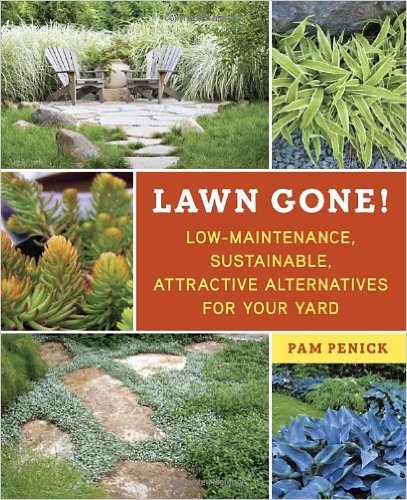The Incredible Shrinking Lawn
By George Graine, Fairfax Master Gardener
Grass is hard and lumpy and damp, and full of black insects. — Oscar Wilde
 During the growing season, was your lawn looking tired? Or were you tired of looking at your lawn? If you answered yes and would like to reduce or even eliminate your lawn, here is a book of ideas: Pam Penick’s Lawn Gone! Low-Maintenance, Sustainable, Attractive Alternatives For Your Yard, published in 2013 by Ten Speed Press.
During the growing season, was your lawn looking tired? Or were you tired of looking at your lawn? If you answered yes and would like to reduce or even eliminate your lawn, here is a book of ideas: Pam Penick’s Lawn Gone! Low-Maintenance, Sustainable, Attractive Alternatives For Your Yard, published in 2013 by Ten Speed Press.
This inspirational treatise presents realistic choices, achievable plans, and simple instructions on how you can have a beautiful yard with less maintenance and cost. Although the title suggests eliminating the lawn, the actual point is having less lawn — rethinking lawn as the default ground cover.
While discussing lawn alternatives, the book recognizes that lawn can have many purposes, such as providing areas for play, entertaining, strolling, or even lying down to look at the night sky. But instead of lawn you could install a water feature such as a pond or disappearing water fountain or even a dry stream bed that mimics the feeling of running water. Other options that may serve your specific purpose include a flagstone patio, a low wooden deck, a fire pit, or a gazebo.
Shrinking your lawn area should result in cost savings – think seed, fertilizer, compost, lime, core aeration, pesticides to combat insects and herbicides to destroy weeds, and — lest I forget — labor. Mowing, edging, and whacking down weeds, whether these are DIY chores or you hire a contractor, will be reduced with less lawn area.
 Lawn Gone provides many color photos to illustrate its points. Your lawn can be more inviting than just a large green swath. The book shows how to integrate low-growing ground covers, dwarf shrubs, ornamental trees, and ornamental grasses and other grass-like plants that require almost no maintenance. You can have any or all of these plant types, including some turf.
Lawn Gone provides many color photos to illustrate its points. Your lawn can be more inviting than just a large green swath. The book shows how to integrate low-growing ground covers, dwarf shrubs, ornamental trees, and ornamental grasses and other grass-like plants that require almost no maintenance. You can have any or all of these plant types, including some turf.
As you think about shrinking your lawn in favor of other plants, consider environmental and climate conditions such as sun and shade, soil type, and deer resistance (the gardeners’ mantra: right plant, right place). These considerations will help you determine a planting palette. At full-service garden centers you will find many types of improved dwarf flowering shrubs, creeping colorful conifers (not just green), and ground covers beyond the ubiquitous pachysandra, vinca minor (periwinkle), liriope, and ajuga.
Be bold! A collection of these plants really makes a statement. In general, look for ground cover plants that will choke out weeds and spread easily by rooting stems or underground shoots.
Is it heresy to consider moss? Absolutely not! However, you must develop a positive attitude for this easy-care perennial. Moss comes in many shapes and textures. Once you get over your aversion to moss, these plants can be addictive, and you may wonder why you ever destroyed them. More heresy? The dreaded (by some) English ivy can be a superb ground cover. This plant is easy to maintain with a pruner. The prime concern is not to let this plant get out of bounds or climb a tree.
Lawn Gone includes a chapter on contending with homeowners association rules as well as county and city regulations. Often such rules or ordinances apply to the front yard, but this is not always the case. For example, if you have lakefront property, your HOA may have an invasive species list that needs to be respected. It is imperative that you know the plant limitations in advance of any lawn makeover.
If the Lawn Gone approach does not suit your plans for a makeover, perhaps you might consider a way to grow a lawn organically. Sarah Little has written a 55-page booklet called Introduction to Organic Lawns and Yards, Plus a Checklist for an Eco-Friendly Property. The June 2016 edition updates the original 2011 version. Dr. Little shows how and why you should change from traditional methods of lawn care to achieve a sustainable and ecological framework for maintaining your property with a minimum of fuss and cost.
Now you have two very different approaches to the lawn. Combining organic lawn care with the Lawn Gone approach could solve many problems.